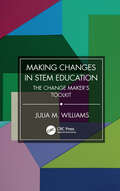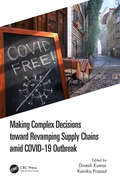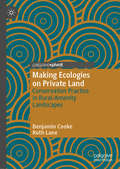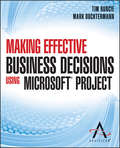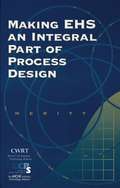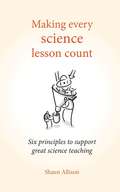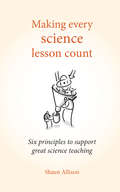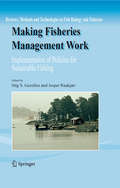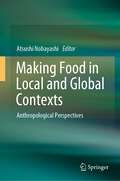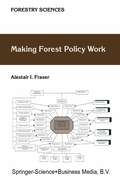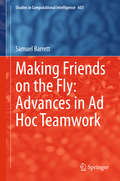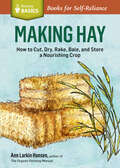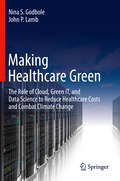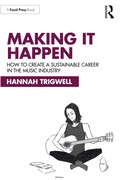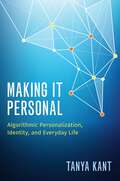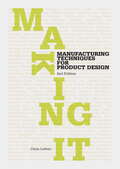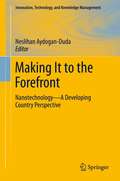- Table View
- List View
Making Changes in STEM Education: The Change Maker's Toolkit
by Julia M. WilliamsMany science, engineering, technology, and math (STEM) faculty wish to make an academic change at the course, department, college, or university level, but they lack the specific tools and training that can help them achieve the changes they desire. Making Changes in STEM Education: The Change Maker’s Toolkit is a practical guide based on academic change research and designed to equip STEM faculty and administrators with the skills necessary to accomplish their academic change goals. Each tool is categorized by a dominant theme in change work, such as opportunities for change, strategic vision, communication, teamwork, stakeholders, and partnerships, and is presented in context by the author, herself a change leader in STEM. In addition, the author provides interviews with STEM faculty and leaders who are engaged in their own change projects, offering additional insight into how the tools can be applied to a variety of educational contexts. The book is ideal for STEM faculty who are working to change their courses, curricula, departments, and campuses and STEM administrators who lead such change work to support their faculties, as well as graduate students in STEM who plan to enter an academic position upon graduation and expect to work on academic change projects.
Making Complex Decisions toward Revamping Supply Chains amid COVID-19 Outbreak
by Dinesh Kumar Kanika PrasadThe COVID-19 pandemic has disrupted supply chains, hence corporations must devise and realign their policies and strategies accordingly to stay competitive in this dynamic situation. This book provides tools to cope with such a scenario and to make appropriate decisions to come out unscathed. Making Complex Decisions toward Revamping Supply Chains amid COVID-19 Outbreak presents the tools and technologies needed to revamp supply chains challenged by the COVID-19 pandemic. The book presents case studies along with historical perspectives for guidance. It explores the supply chain post-COVID-19, discusses the future scenarios of new and emerging supply chains, and describes various multi-criteria decision-making (MCDM) tools used to make complex decisions so companies can stay ahead. The book also offers domain experts’ opinions and views to help organizations formulate real-time strategies. This book is written for researchers, professionals, and undergraduate and postgraduate students to provide an evidence-based cause, effect, and solution after the COVID-19 disaster.
Making Complex Decisions toward Revamping Supply Chains amid COVID-19 Outbreak
by Dinesh Kumar Kanika PrasadThe COVID-19 pandemic has disrupted supply chains, hence corporations must devise and realign their policies and strategies accordingly to stay competitive in this dynamic situation. This book provides tools to cope with such a scenario and to make appropriate decisions to come out unscathed. Making Complex Decisions toward Revamping Supply Chains amid COVID-19 Outbreak presents the tools and technologies needed to revamp supply chains challenged by the COVID-19 pandemic. The book presents case studies along with historical perspectives for guidance. It explores the supply chain post-COVID-19, discusses the future scenarios of new and emerging supply chains, and describes various multi-criteria decision-making (MCDM) tools used to make complex decisions so companies can stay ahead. The book also offers domain experts’ opinions and views to help organizations formulate real-time strategies. This book is written for researchers, professionals, and undergraduate and postgraduate students to provide an evidence-based cause, effect, and solution after the COVID-19 disaster.
Making Ecologies on Private Land: Conservation Practice in Rural-Amenity Landscapes
by Benjamin Cooke Ruth LaneThis book explores conservation practices on private land, based on research conducted with landholders in the hinterlands of Melbourne, Australia. It examines how conservation is pursued as an intimate interaction between people and ecologies, suggesting that local ecologies are lively participants in this process, rather than simply the object of conservation, and that landholders develop their ideas of environmental stewardship through this interaction. The book also explores the consequences of private property as a form of spatial organisation for conservation practice; the role of formative interactions with ecologies in producing durable experiential knowledge; how the possibilities for contemporary conservation practice are shaped by historical landscape modification; and how landholders engage with conservation covenants and payment schemes as part of their conservation practice. The authors conclude with ideas on how goals and approaches to private land conservation might be reframed amid calls for just social and ecological outcomes in an era of rapid environmental change.
Making Effective Business Decisions Using Microsoft Project
by Tim Runcie Doc DochtermannA guide to Microsoft Project that focuses on developing a successful project management strategy across the organization to drive better decisions Making Effective Business Decisions Using Microsoft Project goes far beyond the basics of managing projects with Microsoft Project and how to set up and use the software. This unique guide is an indispensable resource for anyone who operates within a Project Management Operation (PMO) or is affected by the adoption of project management within an organization. Its focus is to provide practical and transitional information for those who are charged with making decisions and supporting corporate and strategic objectives, and who face cost and resource constraints. Because more and more companies are aligning project management with their business strategies, the book not only provides guidance on using Microsoft Project and teaching project management skills, but also includes important information on measuring results and communicating with the executive branch. It also provides valuable guidance in using SharePoint Server for social networking and working within a team. Clearly written and presented, the book: Covers work management using Microsoft Project at multiple levels within an organization Focuses on using Microsoft Project 2010 to integrate and support overall organizational strategies Includes hundreds of graphics, screen shots, and annotations that make it the most accessible and usable guide available on the subject Making Effective Business Decisions Using Microsoft Project is a valuable reference for project managers at all levels, and it sets a new standard for training manuals used by businesses that teach courses on project management using Microsoft Project.
Making Effective Business Decisions Using Microsoft Project
by Tim Runcie Doc DochtermannA guide to Microsoft Project that focuses on developing a successful project management strategy across the organization to drive better decisions Making Effective Business Decisions Using Microsoft Project goes far beyond the basics of managing projects with Microsoft Project and how to set up and use the software. This unique guide is an indispensable resource for anyone who operates within a Project Management Operation (PMO) or is affected by the adoption of project management within an organization. Its focus is to provide practical and transitional information for those who are charged with making decisions and supporting corporate and strategic objectives, and who face cost and resource constraints. Because more and more companies are aligning project management with their business strategies, the book not only provides guidance on using Microsoft Project and teaching project management skills, but also includes important information on measuring results and communicating with the executive branch. It also provides valuable guidance in using SharePoint Server for social networking and working within a team. Clearly written and presented, the book: Covers work management using Microsoft Project at multiple levels within an organization Focuses on using Microsoft Project 2010 to integrate and support overall organizational strategies Includes hundreds of graphics, screen shots, and annotations that make it the most accessible and usable guide available on the subject Making Effective Business Decisions Using Microsoft Project is a valuable reference for project managers at all levels, and it sets a new standard for training manuals used by businesses that teach courses on project management using Microsoft Project.
Making EHS an Integral Part of Process Design
by Arthur D. Little, Inc.This book presents an approach—termed MERITT (Maximizing EHS Returns by Integrating Tools and Talents)—for enhancing process development through better integration of environmental, health, and safety evaluations. It draws upon critical components of inherent safety, pollution prevention, green chemistry, and related paradigms through selective adoption and adaptation of their existing tools, skills, and knowledge resources. MERITT offers ways of enhancing existing best practices of organizations that are recognized leaders in developing and conducting coordinated EHS evaluations through increased awareness and recognition throughout all levels of the organization (engineers, chemists, project managers, and business leaders). Special Details: Hardcover. Co-publishing venture between CWRT and CCPS.
Making Every Science Lesson Count: Six Principles To Support Great Teaching And Learning
by Shaun AllisonMaking Every Science Lesson Count: Six Principles to Support Great Science Teaching goes in search of answers to the fundamental question that all science teachers must ask: 'What can I do to help my students become the scientists of the future?' Writing in the practical, engaging style of the award-winning Making Every Lesson Count, Shaun Allison returns with an offering of gimmick-free advice that combines the time-honoured wisdom of excellent science teachers with the most useful evidence from cognitive science. The book is underpinned by six pedagogical principles challenge, explanation, modelling, practice, feedback and questioning and provides simple, realistic classroom strategies that will help teachers make abstract ideas more concrete and practical demonstrations more meaningful. It also points a sceptical finger at the fashions and myths that have pervaded science teaching over the past decade or so such as the belief that students can make huge progress in a single lesson and the idea that learning is speedy, linear and logical. Instead, Shaun advocates an approach of artful repetition and consolidation and shows you how to help your students develop their conceptual understanding of science over time. Making Every Science Lesson Count is for new and experienced science teachers alike. It does not pretend to be a magic bullet. It does not claim to have all the answers. Rather the aim of the book is to provide effective strategies designed to help you to bring the six principles to life, with each chapter concluding in a series of questions to inspire reflective thought and help you relate the content to your classroom practice. In an age of educational quick fixes, GCSE reform and ever-moving goalposts, this precise and timely addition to the Making Every Lesson Count series provides practical solutions to perennial problems and inspires a rich, challenging and evidence-informed approach to science teaching. Suitable for science teachers of students aged 11 to 16 years.
Making every science lesson count: Six principles to support great science teaching (Making Every Lesson Count Ser.)
by Shaun AllisonMaking Every Science Lesson Count: Six Principles to Support Great Science Teaching goes in search of answers to the fundamental question that all science teachers must ask: ‘What can I do to help my students become the scientists of the future?’ Writing in the practical, engaging style of the award-winning Making Every Lesson Count, Shaun Allison returns with an offering of gimmick-free advice that combines the time-honoured wisdom of excellent science teachers with the most useful evidence from cognitive science. The book is underpinned by six pedagogical principles – challenge, explanation, modelling, practice, feedback and questioning – and provides simple, realistic classroom strategies that will help teachers make abstract ideas more concrete and practical demonstrations more meaningful. It also points a sceptical finger at the fashions and myths that have pervaded science teaching over the past decade or so – such as the belief that students can make huge progress in a single lesson and the idea that learning is speedy, linear and logical. Instead, Shaun advocates an approach of artful repetition and consolidation and shows you how to help your students develop their conceptual understanding of science over time. Making Every Science Lesson Count is for new and experienced science teachers alike. It does not pretend to be a magic bullet. It does not claim to have all the answers. Rather the aim of the book is to provide effective strategies designed to help you to bring the six principles to life, with each chapter concluding in a series of questions to inspire reflective thought and help you relate the content to your classroom practice. In an age of educational quick fixes, GCSE reform and ever-moving goalposts, this precise and timely addition to the Making Every Lesson Count series provides practical solutions to perennial problems and inspires a rich, challenging and evidence-informed approach to science teaching. Suitable for science teachers of students aged 11–16 years.
Making Fisheries Management Work: Implementation of Policies for Sustainable Fishing (Reviews: Methods and Technologies in Fish Biology and Fisheries #8)
by Stig S. Gezelius Jesper RaakjærThe state of the Northeast Atlantic fisheries in recent years has highlighted - plementation as the Achilles heel of modern fisheries management: discards and unreported or misreported landings are in many cases recognised to effectively subvert sound conservation goals. Social science literature on fisheries mana- ment has tended to regard the implementation of resource conservation policies mainly as a question of effective enforcement. This literature regards surveillance and penalty as the key mechanism through which fishermen keep to catch restr- tions and loyally report their catches. This book emerged because several years of research on fishermen’s compliance had made us uneasy about this rather narrow approach to the problem of implementation. This uneasiness motivated us to widen the approach to the question of implementing conservation policies in the fisheries. Taking Norway as an example, its fishing fleet consists of some 7,000 vessels spread along a coastline of more than 20,000 km, populated by less than 5 million people. The idea of ensuring desirable behaviour through surveillance and - forcement alone is almost absurd in such a context, as the task is impossible by any reasonable means. The Norwegian implementation system has thus had to rely heavily on the incentives provided by the rules and legitimacy created through a century of state/industry collaboration. Different coastal states face very different conditions in terms of solving typical implementation problems such as discards and misreporting.
Making Food in Local and Global Contexts: Anthropological Perspectives
by Atsushi NobayashiThis book is a collection of research focusing on the anthropological aspects of how food is made in modern society from both global and local perspectives. Modern food consumed in any society is created in a variety of natural and cultural environments. There is a "food democracy" in which how we procure and share food can be an indicator of our participation in society, while food nurtured in particular climates and land can be transmitted to the outside world owing to the influence of tourism and the global economy, a phenomenon that is recognized on a global scale as exemplified by the UNESCO Intangible Cultural Heritage. In other words, food is an aspect of both culture and civilization. Anthropological approaches are used to reveal the humanistic aspects of food, highlighting the strength and individuality of regional and ethnic foods in global civilizations. The book is a compilation of results from sessions of the international symposium “Making Food in Human and Natural History”, which took place on March 18 and 19, 2019, in Osaka, Japan.
Making Forest Policy Work (Forestry Sciences #73)
by A.I. FraserPolicy issues relating to forestry have been the subject of much debate in recent years, and many countries and international agencies have recently, or are currently in the process, of revising their policies for forestry. Much of this debate has implied that previous policies have failed or been much less successful than had been hoped. There is a tendency to think of policy as a matter for governments, but it is now more widely appreciated that all shareholders in the forestry sector have a legitimate interest in both the policy objectives and the means that will be used to implement it. This book is mainly concerned with the process of developing policy and the subsequent implementation, than in specific content, though many of the important issues which policies must address are discussed. It is based on a review of many case studies with which the author has been personally involved over the past 40 years.
Making Friends on the Fly: Advances in Ad Hoc Teamwork (Studies in Computational Intelligence #603)
by Samuel BarrettThis book is devoted to the encounter and interaction of agents such as robots with other agents and describes how they cooperate with their previously unknown teammates, forming an Ad Hoc team. It presents a new algorithm, PLASTIC, that allows agents to quickly adapt to new teammates by reusing knowledge learned from previous teammates. PLASTIC is instantiated in both a model-based approach, PLASTIC-Model and a policy-based approach, PLASTIC-Policy. In addition to reusing knowledge learned from previous teammates, PLASTIC also allows users to provide expert-knowledge and can use transfer learning (such as the new Two Stage Transfer algorithm) to quickly create models of new teammates when it has some information about its new teammates. The effectiveness of the algorithm is demonstrated on three domains, ranging from multi-armed bandits to simulated robot soccer games.
Making Hay: How to Cut, Dry, Rake, Gather, and Store a Nourishing Crop. A Storey BASICS® Title (Storey Basics)
by Ann Larkin HansenFrom cutting, drying, and raking to baling and storing, this Storey BASICS® guide covers all you need to know to successfully make your own hay.
Making Healthcare Green: The Role of Cloud, Green IT, and Data Science to Reduce Healthcare Costs and Combat Climate Change
by Nina S. Godbole John P. LambThis book offers examples of how data science, big data, analytics, and cloud technology can be used in healthcare to significantly improve a hospital’s IT Energy Efficiency along with information on the best ways to improve energy efficiency for healthcare in a cost effective manner. The book builds on the work done in other sectors (mainly data centers) in effectively measuring and improving IT energy efficiency and includes case studies illustrating power and cooling requirements within Green Healthcare.Making Healthcare Green will appeal to professionals and researchers working in the areas of analytics and energy efficiency within the healthcare fields.
Making It Happen: How to Create a Sustainable Career in the Music Industry
by Hannah TrigwellMaking It Happen is a comprehensive guide to navigating the modern music industry, that redefines what ‘making it’ means for musicians, and inspires and educates musicians on the different options for generating revenue from their art. This book offers theoretical and practical advice on making music, creating promotional content and embracing traditional and emerging social media platforms into your marketing strategies. Through interviews with music industry experts, readers can expect professional tips and advice, as well as clear instructions on how to build a dream team, make content, share that work and grow an audience to enable long-term business sustainability. In the modern music industry, having multiple revenue streams leads to a stable income. Making It Happen offers unique insights into the innovations and technologies available to contemporary music makers, making it essential reading for independent musicians, music business students, music producers and marketers.
Making It Happen: How to Create a Sustainable Career in the Music Industry
by Hannah TrigwellMaking It Happen is a comprehensive guide to navigating the modern music industry, that redefines what ‘making it’ means for musicians, and inspires and educates musicians on the different options for generating revenue from their art. This book offers theoretical and practical advice on making music, creating promotional content and embracing traditional and emerging social media platforms into your marketing strategies. Through interviews with music industry experts, readers can expect professional tips and advice, as well as clear instructions on how to build a dream team, make content, share that work and grow an audience to enable long-term business sustainability. In the modern music industry, having multiple revenue streams leads to a stable income. Making It Happen offers unique insights into the innovations and technologies available to contemporary music makers, making it essential reading for independent musicians, music business students, music producers and marketers.
Making it Personal: Algorithmic Personalization, Identity, and Everyday Life
by Tanya KantTargeted advertisements, tailored information feeds, and recommended content are now common and somewhat inescapable components of our everyday lives. With the help of searches, browsing history, purchases, likes, and other digital interactions, technological experiences are now routinely "personalized." Companies with access to this information often downplay the fact that users' personal data serves as a key form of monetization, and their privacy policies tend to use the terms "personalization" and "customization" to legitimize the practice of tracking and algorithmically anticipating users' daily movements. In Making it Personal, Tanya Kant sheds light on the dilemmas of algorithmic personalization, exploring such key contemporary questions as: What do users really know about the algorithms that guide their online experiences and social media presence? And if personalization practices seek to act on our behalf, then how can users constitute, retain, or relinquish their autonomy and sense of self? At the heart of the book are new interviews and focus groups with web users who-through a myriad of resistant, tactical, resigned or trusting engagements-encounter algorithmic personalization as part of their lived experience on the web. Tanya Kant proposes that for those who encounter it, algorithmic personalization creates epistemic uncertainties that can emerge as trust or anxiety, produces an ongoing struggle for autonomy between user and system, and even has the power to intervene in identity constitution. In doing so, algorithmic personalization does not just generate "filter bubbles" for individuals' worldviews, but also creates new implications for knowledge production, the deployment of cultural capital as an algorithmic tactic, and, above all, formations of identity itself.
MAKING IT PERSONAL C: Algorithmic Personalization, Identity, and Everyday Life
by Tanya KantTargeted advertisements, tailored information feeds, and recommended content are now common and somewhat inescapable components of our everyday lives. With the help of searches, browsing history, purchases, likes, and other digital interactions, technological experiences are now routinely "personalized." Companies with access to this information often downplay the fact that users' personal data serves as a key form of monetization, and their privacy policies tend to use the terms "personalization" and "customization" to legitimize the practice of tracking and algorithmically anticipating users' daily movements. In Making it Personal, Tanya Kant sheds light on the dilemmas of algorithmic personalization, exploring such key contemporary questions as: What do users really know about the algorithms that guide their online experiences and social media presence? And if personalization practices seek to act on our behalf, then how can users constitute, retain, or relinquish their autonomy and sense of self? At the heart of the book are new interviews and focus groups with web users who-through a myriad of resistant, tactical, resigned or trusting engagements-encounter algorithmic personalization as part of their lived experience on the web. Tanya Kant proposes that for those who encounter it, algorithmic personalization creates epistemic uncertainties that can emerge as trust or anxiety, produces an ongoing struggle for autonomy between user and system, and even has the power to intervene in identity constitution. In doing so, algorithmic personalization does not just generate "filter bubbles" for individuals' worldviews, but also creates new implications for knowledge production, the deployment of cultural capital as an algorithmic tactic, and, above all, formations of identity itself.
Making It Second Edition: Manufacturing Techniques for Product Design
by Chris LefteriThere are many ways in which a product can be manufactured but most designers know only a handful of techniques. Both informative and incredibly easy to use, this bestselling book explains over 100 production methods in detail. With specially commissioned diagrams, case studies and step-by-step photographs of the manufacturing process, Making It uses contemporary design as a vehicle to describe production processes. It lists their pros and cons, suitable production volumes, costs involved, speed of production, relevant materials and typical applications. The new edition of this inspirational book also evaluates each process in terms of sustainability and its effects on the environment.Making It appeals not only to product designers but also to interior designers, furniture and graphic designers who need access to a range of production methods, as well as to all students of design. The expanded edition includes nine new processes and an all-new section of 40 finishing techniques.
Making It to the Forefront: Nanotechnology—A Developing Country Perspective (Innovation, Technology, and Knowledge Management #14)
by Neslihan Aydogan-DudaNanotechnology, as shortly described as the study of manipulating matter on an atomic and molecular scale, is one of the most dynamic and promising industries, receiving a great deal of attention from researchers, business leaders, investors, and policymakers around the world. In Making It to the Forefront, Nesli Aydogan-Duda has assembled a distinguished group of authors to analyze the particular challenges and opportunities of nanotechnology emergence and management in the developing world. In so doing, they address the issues from several angles, ranging from cultural issues to capital markets, industrial clusters to government policy and legal structure. Drawing from in-depth research and case studies in Turkey, Latin America, India, China, and Iran, and a comparison with the development of the industry in the United states, the authors present a cross-cultural approach, with particular emphasis on the strategic nature of the nanotechnology industry for economic development, consumer welfare, and homeland security. Among the topics they consider are the importance of knowledge transfer from universities to the market and, more generally, the interface between science and its commercialization—and the institutional infrastructure that is necessary to maximize the potential of science and technology. In doing so, the authors provide unprecedented theoretical and empirical contributions to the study of nanotechnology, and, more generally, insight into the complex business, political, and cultural environment that must be established in order for such an industry to thrive in the context of a developing country.
Making Jet Engines in World War II: Britain, Germany, and the United States
by Hermione GiffardOur stories of industrial innovation tend to focus on individual initiative and breakthroughs. With Making Jet Engines in World War II, Hermione Giffard uses the case of the development of jet engines to offer a different way of understanding technological innovation, revealing the complicated mix of factors that go into any decision to pursue an innovative, and therefore risky technology. Giffard compares the approaches of Britain, Germany, and the United States. Each approached jet engines in different ways because of its own war aims and industrial expertise. Germany, which produced more jet engines than the others, did so largely as replacements for more expensive piston engines. Britain, on the other hand, produced relatively few engines—but, by shifting emphasis to design rather than production, found itself at war's end holding an unrivaled range of designs. The US emphasis on development, meanwhile, built an institutional basis for postwar production. Taken together, Giffard's work makes a powerful case for a more nuanced understanding of technological innovation, one that takes into account the influence of the many organizational factors that play a part in the journey from idea to finished product.
Making Jet Engines in World War II: Britain, Germany, and the United States
by Hermione GiffardOur stories of industrial innovation tend to focus on individual initiative and breakthroughs. With Making Jet Engines in World War II, Hermione Giffard uses the case of the development of jet engines to offer a different way of understanding technological innovation, revealing the complicated mix of factors that go into any decision to pursue an innovative, and therefore risky technology. Giffard compares the approaches of Britain, Germany, and the United States. Each approached jet engines in different ways because of its own war aims and industrial expertise. Germany, which produced more jet engines than the others, did so largely as replacements for more expensive piston engines. Britain, on the other hand, produced relatively few engines—but, by shifting emphasis to design rather than production, found itself at war's end holding an unrivaled range of designs. The US emphasis on development, meanwhile, built an institutional basis for postwar production. Taken together, Giffard's work makes a powerful case for a more nuanced understanding of technological innovation, one that takes into account the influence of the many organizational factors that play a part in the journey from idea to finished product.
Making Jet Engines in World War II: Britain, Germany, and the United States
by Hermione GiffardOur stories of industrial innovation tend to focus on individual initiative and breakthroughs. With Making Jet Engines in World War II, Hermione Giffard uses the case of the development of jet engines to offer a different way of understanding technological innovation, revealing the complicated mix of factors that go into any decision to pursue an innovative, and therefore risky technology. Giffard compares the approaches of Britain, Germany, and the United States. Each approached jet engines in different ways because of its own war aims and industrial expertise. Germany, which produced more jet engines than the others, did so largely as replacements for more expensive piston engines. Britain, on the other hand, produced relatively few engines—but, by shifting emphasis to design rather than production, found itself at war's end holding an unrivaled range of designs. The US emphasis on development, meanwhile, built an institutional basis for postwar production. Taken together, Giffard's work makes a powerful case for a more nuanced understanding of technological innovation, one that takes into account the influence of the many organizational factors that play a part in the journey from idea to finished product.
Making Jet Engines in World War II: Britain, Germany, and the United States
by Hermione GiffardOur stories of industrial innovation tend to focus on individual initiative and breakthroughs. With Making Jet Engines in World War II, Hermione Giffard uses the case of the development of jet engines to offer a different way of understanding technological innovation, revealing the complicated mix of factors that go into any decision to pursue an innovative, and therefore risky technology. Giffard compares the approaches of Britain, Germany, and the United States. Each approached jet engines in different ways because of its own war aims and industrial expertise. Germany, which produced more jet engines than the others, did so largely as replacements for more expensive piston engines. Britain, on the other hand, produced relatively few engines—but, by shifting emphasis to design rather than production, found itself at war's end holding an unrivaled range of designs. The US emphasis on development, meanwhile, built an institutional basis for postwar production. Taken together, Giffard's work makes a powerful case for a more nuanced understanding of technological innovation, one that takes into account the influence of the many organizational factors that play a part in the journey from idea to finished product.
